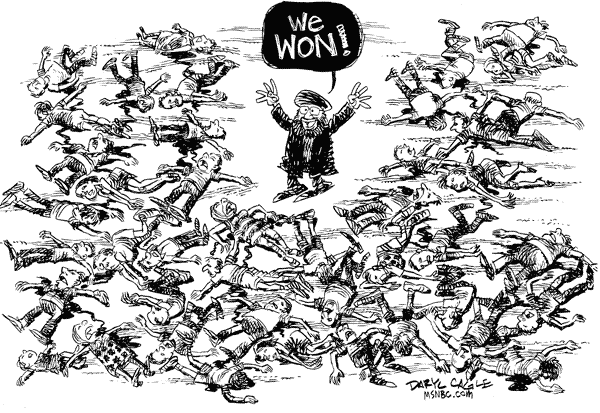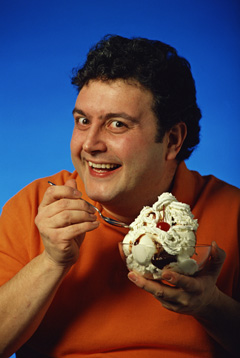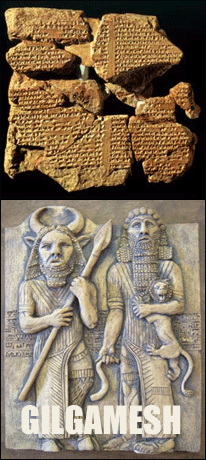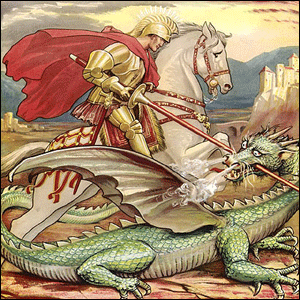
Prepared by Dan Eden for viewzone.com (http://viewzone.com/cognitivedissonance.html)
When "Robbie" the robot was told to shoot a weapon at a man in the movie Forbidden Planet, his electronic brain sparked and short-circuited. His creator had programmed him to never harm a human and so the conflicting ideas paralyzed him.
Human beings often are presented with opposing thoughts also, but our brains have developed a way of resolving these conflicts through a process call cognitive dissonance.
We are taught, like "Robbie," that killing is prohibited -- but what about war? And many anti-abortionists support the death penalty... conflicting behavior is all around us. So how exactly does that work?
Simply put, congitive dissonance theory states that when you have two opposing ideas (or ideologies) at the same time, you will act upon the one that causes the less distortion to your ego.
| According to Wikipedia:Cognitive dissonance is an uncomfortable feeling caused by holding two contradictory ideas simultaneously. The "ideas" or "cognitions" in question may include attitudes and beliefs, and also the awareness of one's behavior. The theory of cognitive dissonance proposes that people have a motivational drive to reduce dissonance by changing their attitudes, beliefs, and behaviors, or by justifying or rationalizing their attitudes, beliefs, and behaviors. Cognitive dissonance theory is one of the most influential and extensively studied theories in social psychology. Dissonance normally occurs when a person perceives a logical inconsistency among his or her cognitions. This happens when one idea implies the opposite of another. For example, a belief in animal rights could be interpreted as inconsistent with eating meat or wearing fur. Noticing the contradiction would lead to dissonance, which could be experienced as anxiety, guilt, shame, anger, embarrassment, stress, and other negative emotional states. When people's ideas are consistent with each other, they are in a state of harmony or consonance. If cognitions are unrelated, they are categorized as irrelevant to each other and do not lead to dissonance. |
Let me give you some examples.
There are lots of schemes and con-artists trying to get your money these days. Almost every day I receive dozens of e-mails from people like Abada Muzoola from Nigeria, who just happened to get my e-mail address and wants me to help him transfer 70-million dollars to my bank in return for a 10 percent commission. Wow, I could use 7-million dollars! All he needs is my bank account number and pin-code. He is even willing to transfer the total amount to my account because he trusts me so much.
I continue to receive variations of this scheme every day. Why? Because they work. Somewhere in the world is a victim who will have cognitive dissonance.
 On a more sophisticated scale, Bernie Madoff [ right] bilked hundreds of wealthy people out of an estimated 50-billion dollars by manipulating the same mental process (and would have continued doing so had he not bragged to his sons, who turned him in).
On a more sophisticated scale, Bernie Madoff [ right] bilked hundreds of wealthy people out of an estimated 50-billion dollars by manipulating the same mental process (and would have continued doing so had he not bragged to his sons, who turned him in).
So how is it that people are able to convince others to give them access to their funds or to willingly give them their cash? First, one more example:
You're walking down a busy street deep in your own private thoughts. All of a sudden a smiling woman jumps out of somewhere, stands in front of you, and puts a flower in your hand. "Hello dear... isn't it a wonderful day today? I want you to have this flower!," she says.Now you have a beautiful flower in your hand. It's a nice gift and she seems friendly. She begins to walk with you, telling you that you have nice, kind eyes. She says she noticed right away that you were special and so wanted to meet you. You forget your previous thoughts about work, bills or your own life. Suddenly you feel good... appreciated... uplifted.
Then, in the same friendly voice and bright smile, she says, "I know you are a good person and you can help me by giving me a something for the beautiful flower -- right?"What happens inside your head at that moment is cognitive dissonance.
The dissonance or dis-harmony comes from two conflicting ideas or decision paths. One path tells you that you should just say "No thanks!" and keep on walking; maybe return the flower and feel insulted even if it means she will become disappointed with you. The other path tells you that she has made you feel good and has earned your friendship and a couple of bucks. She has been friendly and you don't want to ruin the brief relationship you have formed. Heck, you should probably even give her back the flower so she can use it on the next victim.
Which decision will cause the least damage to your ego?
In cognitive dissonance theory the outcome of these opposing thought paths will be the one that requires the least emotional stress. Most victims will pay up rather than feel they are being cruel or disrespectful to someone who has made them feel so good.
In the case of the Nigerian philanthropist, Abada Muzoola, it is often less stressful to believe that you are the lucky "chosen" beneficiary than to believe you are one of the thousands of e-mails he has sent this offer to.
Later, after their bank account has been cleaned out, most people realize that they should have known better and are puzzled by their own vulnerability. Many feel so embarassed that they don't report the crime to the authorities.
Psychologists refer to this vulnerability as the "willful suspension of disbelief," where one can easily see the potential manipulations and evil motives of ther perpetrator, but, because they have already made some prior committment to go along with this, it is easier to continue than to back out.

The investors of Mr. Madoff knew that a 10% to 12% annual return on an investment, especially in the current bear market, was impossible. Something dishonest or illegal had to be going on. But because they had been made to work so hard to let him take their money -- often begging him to please allow them to invest millions of dollars -- they had made the psychological investment that "locks in" the cognitive dissonance. After that, it was more stressful to admit that this was a ponzy scheme than to just avoid worrying about it.
In Festinger and Carlsmith's classic 1959 experiment, students were asked to perform boring and tedious tasks (e.g. turning pegs a quarter turn, over and over again). The tasks were designed to generate a strong, negative attitude. After an hour of working on the tasks, participants were asked to persuade another subject (who was actually a confederate) that the dull, boring tasks the subject had just completed were actually interesting and engaging. Some participants were paid $20 for the favor, another group was paid $1, and a control group was not asked to perform the favor.
When asked to rate the boring tasks at the conclusion of the study, those in the $1 group rated them more positively than those in the $20 and control groups. This was explained by Festinger and Carlsmith as evidence for cognitive dissonance. The researchers theorized that people experienced dissonance between the conflicting cognitions, "I told someone that the task was interesting", and "I actually found it boring." When paid only $1, students were forced to internalize the attitude they were induced to express, because they had no other justification. Those in the $20 condition, however, had an obvious external justification for their behavior, and thus experienced less dissonance.
Are you beginning to understand how this works now?
 In for a dime, in for a dollar
In for a dime, in for a dollar
Cognitive dissonance has been used to control larger groups and populations also. In World War II there was a famous campaign where citizens were asked to donate all their old pots and pans, supposedly to be melted down to make tanks, munitions and war planes. The collection was highly effective and the psychological "investment" initiated solidarity and nationalism for the war effort. Of course, all those pots and pans ended up buried in landfills.
Here's a modern day example: When the US invaded Afghanistan, ex-President Bush came on the television asking families to donate whatever they could to help the school children in Afghanistan who needed paper and pencils. Thousands of school kids collected coins in classrooms across the nation and sent the donations to the White House. The funds ended up being put in to some vague account that never did what it was donated to do. But the "investment" was enough to gain support for a far-away war in an obscure land for vague reasons.
Sometimes, as with the tragic collapse of the World Trade towers on 9-11, the "investment" is made for us. In this way an entire nation can be made to feel that they have already sacrificed something and that they should choose the path of war over peace forgetting about the Iraqi civilian casualties -- or even that Iraq was not responsible.
I once belonged to an Episcopal church in New Mexico that collected oil for M-16s to send to the troops in Iraq! They also invested the church funds with Raytheon and Haliburton.
Cognitive Dissonance in Advertising and Marketing
 In advertising there is a theory that a consumer may use a particular product because he or she believes the advertising for that product, which claims that the product is the most effective of its kind in the job that it does.
In advertising there is a theory that a consumer may use a particular product because he or she believes the advertising for that product, which claims that the product is the most effective of its kind in the job that it does.
Then the consumer may see a competitor's advertisement that seems to prove conclusively that this competitive product is better. This creates dissonance. The consumer must now relieve the uncomfortable feeling that the dissonance brings about and will often do so by switching products. The theory acts as a double-edged sword, though, because while advertisers want to create dissonance for nonusers of their product, they do not want to create it for those who do use their product.
This is why advertisers use their logos on things like NASCAR and sports arenas. They want you to become loyal to their brand. This will create distrust when you see the same product -- even an apparently better product -- with a different and unfamiliar brand.
Cognitive dissonance most often occurs after the purchase of an expensive item such as an automobile. A consumer who is experiencing cognitive dissonance after his or her purchase may attempt to return the product or may seek positive information about it to justify the choice. If the buyer is unable to justify the purchase, he or she will also be less likely to purchase that brand again. Advertisers of high-priced durable goods say that half of their advertising is done to reassure consumers that in purchasing their product the right choice was made.
Some good uses of cognitive dissonance
Congitive therapists use this technique to change bad behavior and decisions. The technique is called a "yes set."
Getting a patient to agree to treatment for addiction or to initiate some beneficial behavior is difficult. There is often a fundamental "batting of heads" between the patient and people trying to help. The breakthrough is achieved when the therapist purposely initiates a series of statements to which the patient can agree. After repeatedly agreeing with the therapist on a multitude of minor decisions, the patient begins to feel good and the therapist allows the patient to "invest" in this positive relationship. Then, with skill, the therapist introduces the crucial decision. "So don't you think it's really time for you go to rehab?" Faced with the option of agreeing or offending the therapist, the patient often continues the "yes" response.
The example above is highly effective because the patient not only agrees to change the bad behavior but is immediately rewarded by the continuation of their positive self-esteem and good feeling.
Cognitive dissonance requires some skill to work
The concept doesn't always work. Especially if it's poorly executed.
I was once shopping for a car and, after selecting a possible make and model, found myself sitting in the little room with the salesman, haggling about the price. At one point he asked me for my driver's license or credit card and told me it was a "gesture" so that I would trust him. At the time, I just said "No way," and split.
For many customers, this simple act would be enough to form a psychological "investment" with the dealer, who could then use this to manipulate and close the sale. It might be more difficult for the customer to demand his lecense or credit card and storm out of the office than to sit there and be intimidated until they signed the sales contract.
Eliminating Cognitive Dissonance
(from www.beyondintractability.org)
 There are several key ways in which people attempt to overcome, or do away with, cognitive dissonance. One is by ignoring or eliminating the dissonant cognitions. By pretending that ice cream is not bad for me, I can have my cake and eat it too, so to speak. Ignoring the dissonant cognition allows us to do things we might otherwise view as wrong or inappropriate.
There are several key ways in which people attempt to overcome, or do away with, cognitive dissonance. One is by ignoring or eliminating the dissonant cognitions. By pretending that ice cream is not bad for me, I can have my cake and eat it too, so to speak. Ignoring the dissonant cognition allows us to do things we might otherwise view as wrong or inappropriate.
Another way to overcome cognitive dissonance is to alter the importance (or lack thereof) of certain cognitions. By either deciding that ice cream is extremely good (I can't do without it) or that losing weight isn't that important (I look good anyway), the problem of dissonance can be lessened. If one of the dissonant cognitions outweighs the other in importance, the mind has less difficulty dealing with the dissonance -- and the result means that I can eat my ice cream and not feel bad about it.
Yet another way that people react to cognitive dissonance is byadding or creating new cognitions. By creating or emphasizing new cognitions, I can overwhelm the fact that I know ice cream is bad for my weight loss. For instance, I can emphasize new cognitions such as "I exercise three times a week" or "I need calcium and dairy products" or "I had a small dinner," etc. These new cognitions allow for the lessening of dissonance, as I now have multiple cognitions that say ice cream is okay, and only one, which says I shouldn't eat it.
Finally, perhaps the most important way people deal with cognitive dissonance is to prevent it in the first place. If someone is presented with information that is dissonant from what they already know, the easiest way to deal with this new information is to ignore it, refuse to accept it, or simply avoid that type of information in general. Thus, a new study that says ice cream is more fattening than originally thought would be easily dealt with by ignoring it. Further, future problems can be prevented by simply avoiding that type of information -- simply refusing to read studies on ice cream, health magazines, etc.
Cognitive dissonance is all around us. We live in a world full of contradictions. Children are killed in Gaza in the name of peace. Feminists wear makeup, short skirts and high heels. Conservationists like Al Gore fly around in private, fuel guzzling jets. Anti-gay Christians tap their feet in public bathroom stalls... these opposing ideologies are all resolved somehow, somewhere, deep in our human psyche with cognitive disonnance.

 I'm going to describe the cutting-edge of psychological theories, called Terror Management Theory or TMT. It's been known for a while but has been kept off the radar by the media. And that's partially because TMT has been used against us (you will see how). It's a theory that explains human behavior and its most basic psychological motivator.
I'm going to describe the cutting-edge of psychological theories, called Terror Management Theory or TMT. It's been known for a while but has been kept off the radar by the media. And that's partially because TMT has been used against us (you will see how). It's a theory that explains human behavior and its most basic psychological motivator.

 Laboratory experiments investigating aggressive behavior pose a problem. If the aggression is directed towards a real person there is the risk of someone being hurt or injured. Psychologists have invented numerous means of assessing aggression in indirect ways. A group of experimenters recently developed a new method for measuring aggression, specifically, the amount of hot sauce administered to a target known to dislike spicy foods [10].
Laboratory experiments investigating aggressive behavior pose a problem. If the aggression is directed towards a real person there is the risk of someone being hurt or injured. Psychologists have invented numerous means of assessing aggression in indirect ways. A group of experimenters recently developed a new method for measuring aggression, specifically, the amount of hot sauce administered to a target known to dislike spicy foods [10].

 While it is true that there are earlier texts showing language in cuneiform, these are mere ledgers, records of land boundaries and crop tallies. There is no hint of self awareness until
While it is true that there are earlier texts showing language in cuneiform, these are mere ledgers, records of land boundaries and crop tallies. There is no hint of self awareness until  Some of this anxiety can be exhorcize in sports or games but more often the demons are symbols of a threat to our personal and collective self-esteem. A threat to a group that reduces our death anxiety is a real threat. I suspect this motivated the cruelty of Roman gladiators, the deadly ball games of the Mayans and the demonization of Hitler and binLaden. We need enemies to reduce our own death anxiety.
Some of this anxiety can be exhorcize in sports or games but more often the demons are symbols of a threat to our personal and collective self-esteem. A threat to a group that reduces our death anxiety is a real threat. I suspect this motivated the cruelty of Roman gladiators, the deadly ball games of the Mayans and the demonization of Hitler and binLaden. We need enemies to reduce our own death anxiety.